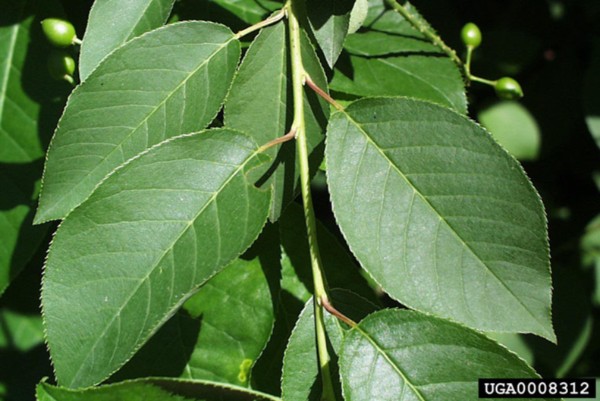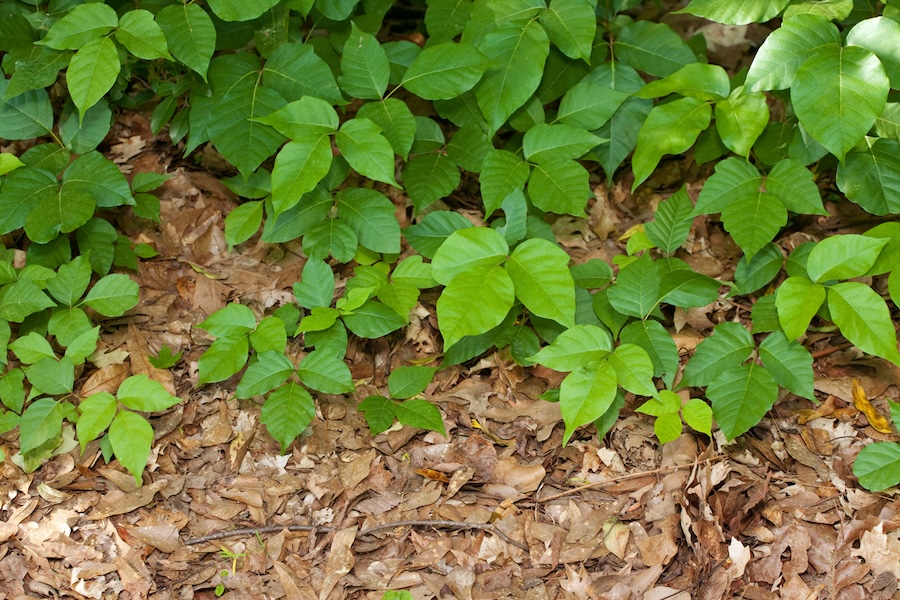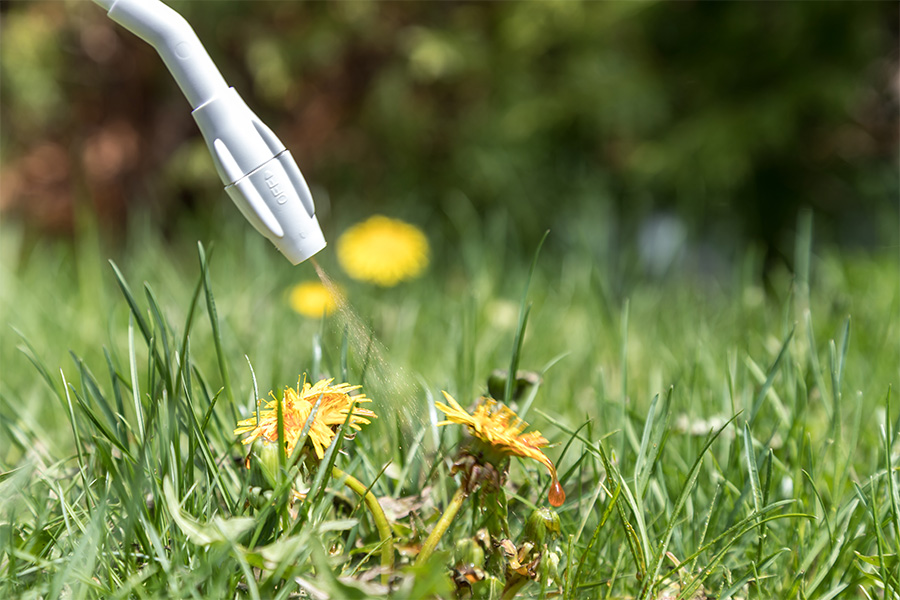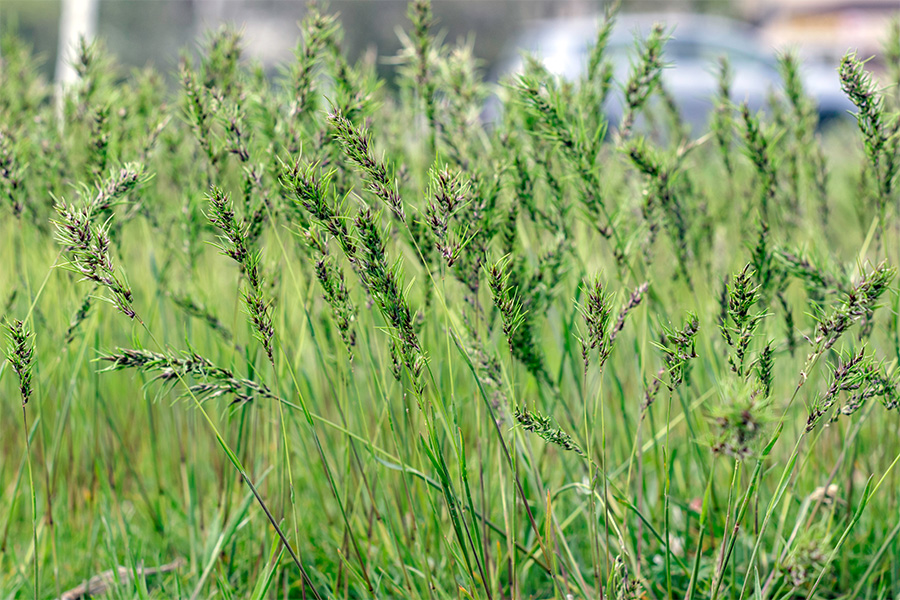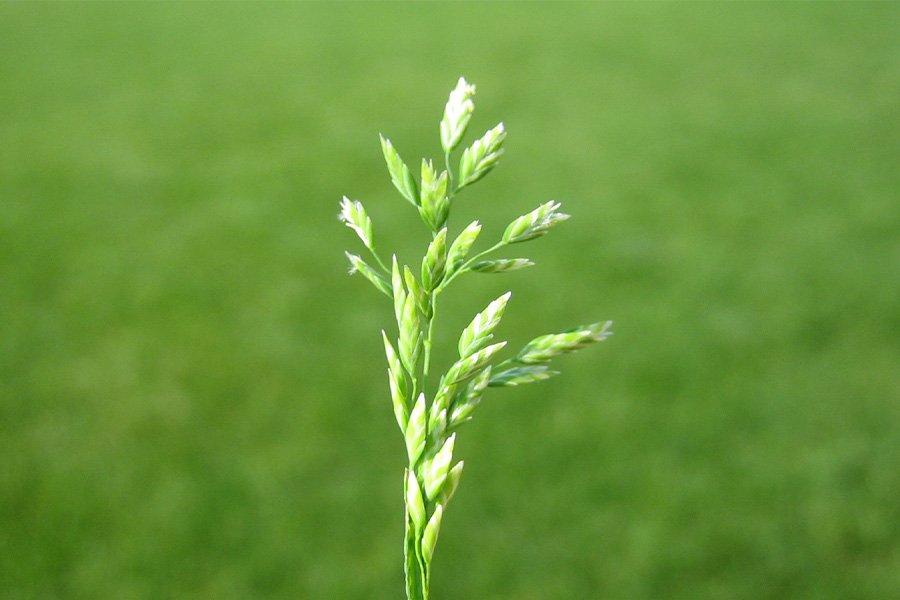Toxic Weed Identification
Top 22 Toxic Weeds that Affect the Southeast
Black Cherry
Description
Medium-sized tree.
· Dark Smooth Bark.
· Fruits are black, shiny, juicy.
· Leaves are alternate.
* 2 ½ - 5 in. long
* 1 – 2 in. wide
Commonplace in fencerows and edges of pastures.
Animals Affected
· Ruminants (cattle, sheep, goats, etc.) more commonly affected.
· Horses and other single-stomach animals can also be affected.
Signs
· Difficulty breathing.
· Anxious/staggering, collapse, and convulsions before death.
· Animals may show signs within 15-30 minutes after consuming and may die within one hour.
· Mucous membranes and the blood are bright “cherry” red in color.
Toxicity
•Hydrocyanic acid (also called prussic acid), created by enzymatic action on the glucoside amygdalin.
•It is present primarily in the wilted leaves (i.e. fallen trees), but the bark and twigs are also toxic.
Black Locust
Description
· Medium-sized tree.
* Deeply furrowed, thick bark.
* Paired thorns at the base of each compound leaf.
* Eaves are alternate, pinnately compound.
· Flowers are showy, white, very fragrant and droop.
· Commonplace in fencerows and edges of pastures.
Animals Affected
· Affects horses, cattle, sheep, poultry, and humans.
* Horses are the most susceptible.
* Are goats susceptible? Not as many cases but can still be.
Signs
· Depression, loss of appetite, weakness, dilated pupils.
· Posterior paralysis, irregular pulse, difficulty breathing, and bloody diarrhea.
Toxicity
•Glycoside robitin.
•Poisoning usually occurs by ingesting roots, bark, sprouts, seed pods, or trimmings.
Brackenfern
Description
· Coarse perennial fern to 3ft tall.
* Older fronds leathery, triangular.
* Rhizomatous.
· Common in old fields, waste places, open woods, roadsides, and particularly on relatively dry sites.
Animals Affected
· Affects all forage-fed livestock.
* Horses are the most susceptible.
* Are goats susceptible? Not as many cases but can still be.
Signs
· Monogastrics lack coordination, often standing with legs spread apart as if bracing.
· Arched back and neck.
· Fever is present up to 104o F.
· Before death, horses may “head press” against objects and have spasms.
· Cattle may exhibit stages of signs.
· Laryngeal stage
* Difficult and loud breathing.
* More typical in younger animals.
· The enteric stage
* Bloody feces/urine and excessive bleeding from fly bites.
· The blood is slow to clot since platelets are deficient.
· Sheep and goats may show blindness due to degeneration of the retinal epithelial cells.
* Sheep and goats tens to avoid brackenfern more.
Toxicity
•Contains the enzyme thiaminase.
* Inactivates thiamine (Vitamin B1).
* Causes bone marrow to fail to produce new blood cells.
•All portions of the plant are toxic whether green or dry.
•Poisoning by the plant is cumulative.
* Builds up over time.
* Symptoms may not be immediate.
•Remains toxic if baled in hay.
Buttercup
Description
· Low annual or perennial.
· Stem leaves alternate, simple, lobed or divided.
· Flowers usually with five glossy yellow petals (hence name).
· Occurs throughout the South.
* Common in old fields, waste places, open woods, roadsides, and particularly in relatively wet areas (near creeks, clayey soils).
Animals Affected
· All livestock are affected.
· Plant is very unpalatable and typically avoided by livestock unless forage/feed is limited.
Signs
· Abdominal pain, severe diarrhea, convulsions, and death.
· Milk from affected cows will be bitter and may be reddish in color.
Toxicity
•Contains an irritant oil called protoanemonin, derived from glycoside rarunculin.
•When flowering, more toxin present than the younger plant.
* Present in the stems and leaves.
Castor Bean
Description
· Large woody annual (in the south), or perennial (in the tropics).
* Leaves alternate, up to 16” long, palmately lobed, serrated with gland-tipped teeth.
* Seeds (3/capsule) are shiny, mottled brown, resembling a tick.
· Cultivated ornamental throughout the South, occasionally escaping.
* Planted as mole repellant.
Animals Affected
· Horses and monogastrics (particularly hogs) are the most susceptible to poisoning, but all livestock and humans can be affected.
Signs
· Depending upon the amount consumed, signs appear several hours to days after consuming toxin.
· Violent purgation (straining and bloody diarrhea).
· Abdominal pain, weakness, trembling, and lack of coordination.
Toxicity
•The poisonous principle is a phytotoxin called ricin.
* Inhibits protein synthesis.
* Highly toxic (Low LD50).
•All parts of the plant are toxic, especially the seeds.
•Toxicity is seen most often in spring and summer.
Chinaberry
Description
· Small to medium-sized tree.
* Leaves alternate, deciduous, bipinnately compound.
* Leaflets deeply toothed at margins.
* Fruit one-seeded, greenish yellow to yellow-tan, ½” in dimeter.
· Found throughout the South, but rare in the northern areas.
* Once an ornamental but widely escaped.
* Found along roadsides and fence rows, in waste places, and around buildings.
Animals Affected
· Swine and sheep are most often affected.
* Toxicity may occur after consumption of more then 0.5% of body weight.
· Goats, poultry, and cattle can be poisoned, but larger amounts are required.
Signs
· Stomach irritation, vomiting, bloody diarrhea, paralysis, irregular breathing, and respiratory distress.
Toxicity
•The toxins are tetranortriterpene neurotoxins and unidentified resins.
•The fruit (berries) are the most toxic part of the tree.
•The leaves, bark, and flowers are mildly toxic and usually are no problem.
•Most poisonings occur in the fall or winter when the berries ripen.
Cocklebur
Description
· Coarse, branching annual weed, 1-3 feet.
* Leaves alternate, simple, coarsely pubescent, shallowly lobed.
* Fruit broadly cylindrical, spiny bur, ½ - 1” long.
· Found throughout the South.
· Most abundant in fertile soil gardens, fields, roadsides, etc. in full sunlight.
Animals Affected
· Swine are the animals most commonly poisoned.
* They root up and ingest the two-leaf stage of the plant in the springtime.
· Chickens are other livestock have also been poisoned but are less likely to consume more potent plant parts.
Signs
· Vomiting and gastrointestinal irritation with occasional diarrhea.
· Large amounts often cause nervous signs, including spasmodic running movements and convulsions.
Toxicity
•Principle toxin is the glycoside carboxyatractyloside.
* It is concentrated in the seeds and seedlings (cotyledon state).
•Mature plants are distasteful to animals and contain less of the toxin.
Dallisgrass Ergot
Description
· Found on dallisgrass seedheads.
* Warm season perennial grass, that grows in loose bunch.
* Seed head had 3-6 spikes arising from different points long stem. The spikes often droop.
· Fungal mass (ergot body) grows in place of a seed.
· Begins as a tan/orange, round mass and becomes black and shrunken.
Animals Affected
· All grazing animals.
Signs
· May occur as early as 3 days after introduction to an infected forage.
· “Staggers,” or lack of coordination, trembling, progressing to struggling to walk or causing the animal to get down and be unable to stand.
· Deaths are rare except in cases of injury associated with incoordination.
Toxicity
•Tremorgenic mycotoxin, paspalitrems.
•Interferes with nerve signals and nervous system activity.
•Found only in affected seedheads.
•Mycotoxin is stable when dry and can cause effects if hay is contaminated.
Ground Cherry
Description
· Annual or perennial herbs.
* Branched and spreading at the top.
* Leaves alternate, simple, smooth margined or irregularly toothed.
* Funnel-shaped, yellowish flowers.
* Fruit a globose yellow, red to purple berry surrounded by a papery sac.
Typically found in disturbed areas, thin woodlands, field edges
Animals Affected
· All grazing animals are susceptible.
Signs
· Weakness, excess salivation, shortness of breath, trembling, progressive paralysis.
· Acute hemorrhagic gastroenteritis.
· Collapse and death.
Toxicity
•Solanine and other solanidine alkaloids.
•Toxins concentrated in unripe berries and leaves.
* No toxicity in ripe berries.
Hemp Dogbane
Description
· Perennial herb with milky juice.
* Leaves opposite, simple, margins not toothed.
* Flowers small, pink-tinged, bell shaped.
* Fruit of 2 long and slender pods with many silky-haired seeds.
· Frequently found in disturbed areas, roadsides, and field edges.
Animals Affected
· All grazing animals are susceptible.
Signs
· Rapid pulse, dilation of pupils, weakness, convulsions, vomiting.
· Blue coloration of mucous membranes.
· Mild myocardial degeneration to cardiac arrest and death.
* Death generally occurs within 6-12 hours of consumption.
Toxicity
•Resins and cardiac glycosides, including cymarin, which was once used as a cardiac stimulant.
•All plant parts contain the toxins, whether fresh or dry.
•Lethal dose may be less than 15 grams.
Horsenettle
Description
· Perennial, thorny weed ½ - 1 ½ feet tall.
* Leaves alternate, simple, irregularly pinnately lobed.
* Flowers white to purple, borne in terminal racemes.
* Green fruit turn yellow, resembling a small tomato.
· Found throughout the South and common in pastures, and old fields.
Animals Affected
All grazing animals are susceptible.
Signs
· Weakness, excess salivation, shortness of breath, trembling, progressive paralysis.
· Acute hemorrhagic gastroenteritis.
· Collapse and death.
Toxicity
•Solanine and other solanidine alkaloids.
•All plant parts are toxic.
* Toxins concentrated in berries and are more toxic when mature (yellow).
Jimsonweed
Description
· Coarse, foul-smelling, annual, ½ - 2 feet tall, with purple-tinged stems.
* Leaves alternate, coarsely and irregularly toothed.
* Large, white to lavender, flowers.
* Fruit is spiny capsule with many black, shiny seeds.
· Distributed throughout the South; most abundant in fertile fields, gardens, and barn lots.
Animals Affected
· All livestock are susceptible to the toxins.
* Cattle and swine are most commonly affected.
Signs
· Weak rapid pulse and heartbeat, dilated pupils, dry mouth, incoordination, convulsions, coma.
Toxicity
•The toxic principles are the tropane alkaloids atropine, hyoscyamine, and scopolamine.
•All parts of the plant are considered poisonous, whether green or dry.
* The seeds are particularly poisonous.
Johnsongrass
Description
· Coarse perennial grass up to 8 feet tall.
* Leaves may be up to 3 feet long and 2 inches wide.
* Panicle often brown to purplish, that can be as broad as up to 18 inches wide.
· Found throughout the South, especially in old fields, waste places, and fence rows.
Animals Affected
· Ruminants (cattle, sheep, goats, etc.) more commonly affected.
· Horses and other single-stomach animals can also be affected.
Signs
· Difficulty breathing.
· Anxious/staggering, collapse, and convulsions before death.
· Animals may show signs within 15-30 minutes after consuming and may die within the hour.
· Mucous membranes and the blood are bright red in color.
Toxicity
•Hydrocyanic acid (also called prussic acid), created by enzymatic action on the glycoside dhurrin.
•It is present primarily in stressed and damaged leaves (i.e. wilted by drought, frost, trampling, etc.).
Milkweed
Description
· Erect summer perennial weed.
* Milky sap from stems and roots.
* Leaves are simple and opposite, whorled or alternate.
* Flowers are in dense, showy umbels (various colors).
* Fruit is an elongated follicle splitting on one side, that releases many seeds topped with white, silky hairs.
· Found throughout the South in old fields, and along roadsides and fence rows.
Animals Affected
· All animals are susceptible.
Signs
· Staggering, convulsions, bloating, labored breathing, dilated pupils, rapid and weak pulse, coma, death.
Toxicity
•Steroid glycosides and toxic resinous substances.
•Toxins are present in all plant parts, whether green or dry.
Oleander
Description
· Ornamental shrub, 4-30 feet tall.
* Leaves opposite or whorled, evergreen, and leathery.
* Flowers are showy (various colors) in large terminal clusters.
· Found in Costal Plain from Florida to Louisiana, particularly near coast and escaping along roadsides, edges of woods, and fence rows.
Animals Affected
· All animals are susceptible.
Signs
· Severe gastroenteritis, vomiting, diarrhea, increased pulse rate, weakness, death.
Toxicity
•Digitoxin-type glycosides (oleandroside, nerioside, and others).
•Toxins are present in all plant parts, whether green or dry.
•Toxins may also be inhaled in smoke when plants are burned.
•Human poisoning occasionally occurs from using sticks from nearby oleander plants to roast food.
Perilla Mint
Description
· Annual herb, ½ - 2 feet tall.
* Stems are four-sided and freely branched.
* Leaves are opposite, purple or green, ovate, coarsely serrate, with a strong pungent order when crushed.
* Flowers are small, white to purple, in terminal panicles.
· Found throughout the South, mostly in pastures and fields, along roadsides, and old home sites.
Animals Affected
· Most often affects cattle and horses. Can affect other grazing livestock.
* May cause birth defects in calves when hay containing perilla mint is fed to cows early in gestation.
Signs
· Occur 2-10 days after exposure.
· Labored breathing, lowered head, reluctance to move, death on exertion.
* Pulmonary emphysema (restrictions) and edema (fluid buildup)
Toxicity
•The principle toxin is a furan (perilla ketone).
•Toxins are present in all plant parts, whether green or dry.
•Toxic cases are seen sporadically, usually in the late summer or fall after grazing the plant.
Poison Hemlock
Description
· Highly branched biennial herb, up to 7 feet tall, with hollow spotted stems.
* Leaves resemble parsley and have a parsnip odor when crushed.
* Flowers are white, in umbles.
· Found throughout the South, typically in damp waste areas.
Animals Affected
· All animals are susceptible.
* Famous for its use in ancient Greece to poison condemned prisoners, including Socrates.
* Children are sometimes poisoned when using the hollow stems as “pea-shooters.”
Signs
· Dilated pupils, weakness, staggering gait, slow pulse progressing to rapid.
· Trembling and jerking motions are followed by convulsions.
· Slow, irregular breathing, and death from respiratory failure.
· Chronic ingestion may lead to abnormal fetal development.
Toxicity
•Piperidine alkaloids (coniine and others) in all vegetative parts.
* The stems, leaves, and mature fruits are toxic.
* The leaves are more dangerous in the springtime, and the fruit is the most dangerous in the fall.
Pokeweed
Description
· Perennial herb, up to 9 feet tall.
* Stems green to red/purple, fleshy, smooth.
* Leaves alternate, light green, lanceolate.
* Flowers white to purplish in drooping racemes.
* Ripe fruit black, juicy, that stains.
· Distributed throughout the South. Most common on waster ground, fence rows, pastures, and old home sites.
Animal Affected
· Pigs, cattle, sheep, horses, and humans.
Signs
· Vomiting, abdominal pain, bloody diarrhea, breakdown of red blood cells, drop in milk production.
· Convulsions, death from respiratory failure.
* Post-mortem often reveals ulcerative gastritis, mucosal hemorrhage, dark liver.
· Most animals recover within 24-48 hours after removing threat.
Toxicity
•Principle toxins include oxalic acid, a saponin (phytolaccotoxin), and an alkaloid (phytolaccin).
•Toxins are present in all plant parts, but the roots are the most toxic.
Rhododendrons & Azaleas
Description
· Shrub or densely branched small tree 3-10 feet tall.
* Leaves are alternate, leathery, evergreen (some azaleas are deciduous), lanceolate to elliptic.
* Flowers are showy, white, red, pink, or purple in terminal clusters.
· Naturally found in the Appalachian mountains, but used as ornamentals throughout the South.
Animals Affected
· Ruminants (cattle, sheep, goats, etc.) more commonly affected.
· Horses and other single-stomach animals can also be affected, but are less likely to graze these plants.
Signs
· Bloating, salivation, vomiting, and abdominal pain as evidenced by straining.
· Eventually the animals grow weak, stagger, and become prostrate.
Toxicity
•Andromedotoxin is the principle toxin. Some may also contain a glucoside od hydroquinone.
•Toxins are present in all plant parts, but particularly the leaves.
•Poisoning can occur at any time of the year.
* More commonly seen in the early spring or in the wintertime.
Sesbania
Description
· Annual legume, 2-7 feet tall.
* Stem is often woody at base.
* Leaves are pinnately compound and alternate.
* Flowers yellow, often streaked with purple, in 206 clusters.
* Pods are linear and contain 30-40 seeds that break free when mature and dry.
· Found mostly in Coastal Plain from Virginia to Florida to Texas, most abundant alongside ditches/stream banks.
Animals Affected
· All animals are believed to be susceptible.
Signs
· Variable but include rapid pulse, weak respiration, stiff gait, walk with arched back, diarrhea, death.
* Progression of signs may be a matter of hours.
· Affected animals are often found dead. Post mortem may reveal seeds in the rumen and a hemorrhagic inflammation of the abomasum and intestines.
Toxicity
•The principle toxin is a saponic glycoside.
* Exact toxin and mechanism are unclear.
•It is believed that all plant parts are toxic, but the seeds are most toxic.
* Some animals seem to develop a desire for the seeds.
Sicklepod
Description
· Coarse annual weed 1-2 feet tall.
* Leaves alternate, pinnately compound with 4-6 obovate leaflets.
* Yellow flowers.
* Sickle-shaped pods, split along two lines, 4-8” long.
· Found throughout the South, but most abundant in cultivated fields, roadsides, waste places, and open pinelands.
Animals Affected
· All forage fed livestock are susceptible to the toxins.
· Consumption of sicklepod is rare in a pasture, unless forage is restricted.
* Risky contaminant in silage and hay crops, particularly from annual pastures.
Signs
· Diarrhea is usually the first symptom.
· Later, the animals go off feed, appear lethargic, but have no fever.
· Muscle degeneration causes tremors and eventually the animals’ urine becomes dark and coffee colored.
· Animal becomes too weak to stand.
· Death often occurs within 12 hours after the animal goes down.
Toxicity
•Anthraquinones, emodin glycosides, toxalbumins, alkaloids.
•Toxin affects skeletal muscles, kidney, and liver.
•Seeds contain highest concentration of toxin. The leaves and stem whether green or dry, also contain toxin.
* Consuming the plant in the field or in conserved forage can lead to problems.
Sneezeweed
Description
· Annual or perennial herb, usually 1-3 feet tall.
* Leaves are narrow, alternate, simple.
* Flowers are yellow and borne on heads.
· Found throughout the South in pastures, roadsides, and bogs.
· Species vary with location.
* Autumn sneezeweed is more common in Piedmont/Mountains
* Bitter sneezeweed is more common in the South Piedmont and Coastal Plain.
Animals Affected
· All livestock can be affected.
* Sheep tend to be more commonly affected.
* Cattle may require more to be affected.
Signs
· Severe irritation of the mucous membranes.
· Dullness, trembling, restlessness, stiff gait, salvation, and weakness are the first symptoms.
· Severe vomiting, hence the name “spewing sickness.”
* Vomiting animals may inhale part of the regurgitated material into the trachea and develop inhalation pneumonia.
Toxicity
•The toxic principles are the glucoside sesquiterpene lactone and a phenol.
•The toxins can be found in all plant parts.
* When crushed the leaves of bitter sneezeweed have a strong odor.
•Toxins remain even after drying.
* Contaminated hay can cause problems.
•Most cases occur when forage supplies are limited.
There are no events to display.


